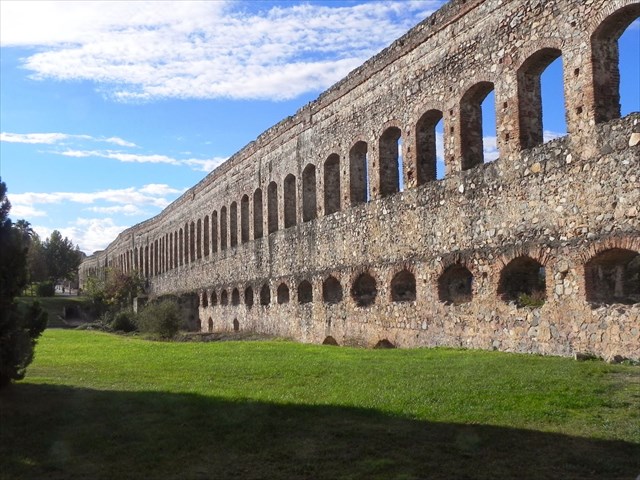
Este acueducto es el que permitía salvar el valle del Albarregas a una red de conducciones de aguas que, procedente de manantiales y arroyos subterráneos ubicados al Norte de la ciudad, aún se conserva íntegra en buena parte de sus tramos.
El canal comenzaba a quedar suspendido en el lugar conocido como “Rabo de Buey”, donde se ubicó una piscina para la decantación de impurezas que pudieran llevar las aguas. Hoy se erige la caseta de un sifón del siglo XIX. Fue el acueducto más largo de la Colonia, de los dos constatados, con más de un kilómetro y medio de longitud. Por su fábrica parece ser también el más antiguo, parejo a la edificación de los edificios para espectáculos.
De todas las arquerías de este acueducto sólo restan los tajamares de algunas pilas y, sobre todo, los tres pilares que vemos junto al arranque de un arco de medio punto de ladrillo y los dos arcos de medio punto a base de bellas dovelas de granito, en los que con efectismo, se mezcla el sillar de granito y el ladrillo con el hormigón que le sirve de núcleo.
En el siglo XVI el acueducto romano estaba inutilizado. En lugar de restaurarlo, el ayuntamiento prefirió construir otro nuevo, que se conserva en toda su integridad. Por último, también podemos ver restos de una termas romanas construidas a pocos metros del acueducto.
This aqueduct allowed covering the Albarregas valley with a network of channels that brought water coming from underground springs and streams located north of the city and it is still completely preserved in most of its stretches.
The channel was perched in a place called “Oxtail” (Rabo de buey) where a reservoir was placed to purify the water. Today we can find a small siphon house from the 19th century. It was the longest of the two aqueducts of the Colony that were found and it was more than one kilometre and a half long. Because of its construction, it also seems the oldest one, similar to the construction of the buildings for spectacles.
Of all the arches in this aqueduct, only the cutwaters of some of the piers are left as well as, especially, the three pillars that we see next to the base of a semicircular arch made of bricks and the two semicircular arches based on beautiful granite voussoirs in which granite ashlars and bricks with concrete serving as the core, are sensationally combined.
In the 16th century the Roman aqueduct was not used. Instead of restoring it, the town hall preferred building a new one which has been completely preserved. Finally, we can also see the remains of some Roman thermae which were built only a few meters from the aqueduct.